|
|
Now how could I possibly be comparing that great
Turkish patriot, feminist and humanitarian, Halide Edib, with one of the more
infamous Turkish opportunists of our day, Fatma Muge Gocek,
who is so allergic to matters Turkish?
As you can read from the headline, there is a caveat. A pretty big one.
Let's first have an introduction to the marvelous Halide Edib and her
book, "House With Wisteria — Memoirs of Halidé Edib,"
a relevant portion of which will follow:
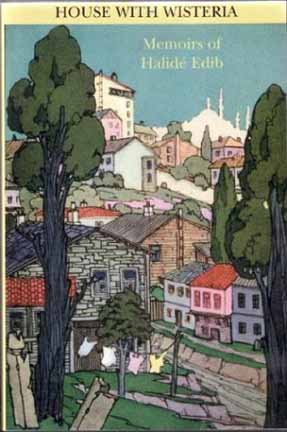 |
|
Front
cover for the paperback of Halide Edip's book |
Considered from the point of view of
the feminist historian and critic... the memoirs take on further significance,
since they tell the story of a pioneering woman who perceived her making as an
individual, an intellectual, and a writer as inseparable from the birth of a
nation: she claimed to write her name into history as the writer of Turkey's
nationalist history. In other words, she never conceived her memoirs as merely
personal narrative. In presenting to the world the true history of the
nationalist struggle of her people, she saw herself as engaging in the most
public form of narration: recounting one of the greatest epics of modern
Europe,' as she puts it in the epilogue to the first volume. At the same time,
Edib's memoirs are multilayered; they can be read as the memoirs of a
participant in and builder of the master-narratives of Turkish enlightenment
and Turkish nationalism; yet they also tell us that story from a woman's point
of view. Not only do they shadow the political autobiography with the history
of the domestic sphere; they also disclose the private dimensions of the
public story itself.
(Ayse Durakbasa, A Turkish Woman Writer in Exile, "Women's
Lives/Women's Times: New Essays on Auto/Biography," SUNY Press, 1997,
p. 158)
|
|
|
| "House
With Wisteria, " pp. 318-320 |
... It was then that Mehemmed Ali Tewfik, a young journalist, made a most emphatic speech
full of rhetorical effect enthusiastically suggesting that these writers should not only
stay but should even find some way of being martyred, and thus seal the sacred cause of
nationalism with their blood. Although in those days it was easy enough to get oneself
killed, still the writers thus complimented as being worthy of death looked a little
queer. Mehemmed Emin, whose name was the first, sat with his hands folded, contemplating,
and my humble self, who was also among the chosen, wondered what sort of death Mehemmed
Emin contemplated. There were twinkles in many friendly eyes. And I really think that it
was the supreme joke in those tragic days.
The Dardanelles attack passed, but there was trouble on the East Anatolian front. There
were rumors about Armenian deportations and their bloody consequences. There was talk of
the Armenians having burned Turkish villages at the front and having massacred Turks, and
talk of the danger they were creating behind the Turkish army by their revolutionary
centers. It was long after this event that the government published a book on the subject
exposing the crimes in eastern Anatolia. When the deportations became general, public
opinion was sincerely against the government. But the country was then in the thick of the
fight, and nothing was published on the subject. It was an extremely difficult time for
the Turkish population; in spite of the public disapproval of the government's acts, every
Turk was deeply conscious of Turkey's danger, and that it would mean complete spoliation
and extermination of the Turks if the Turkish army should be defeated. One naturally felt
that Armenian revolutionary centers were used as the strategic points to carry out allied
policy against the Turks. Besides this political argument, which the Armenians did their
best to justify by their own bloody deeds, there was a strong economic one, morally
supported by the Germans. This was to end the economic supremacy of the Armenians, thereby
clearing the markets for the Turks and the Germans. There is no doubt that the foreign
policy which caused the elimination of Armenians and Turks in the vast lands of Turkey
took well into account that nature fills up the open spaces of economic value, and that
the spaces left empty by the mutual massacre of the peoples in Turkey would be taken up by
the European countries with surplus populations.
There are two factors which lead man to the extermination of his kind: the principles
advocated by the idealists, and the material interest which the consequences of doing so
afford certain classes. The idealists are the more dangerous, for one is obliged to
respect them even if one cannot agree with them. Talaat was of that kind. I saw Talaat
very rarely after the Armenian deportations. I remember well one day when he nearly lost
his temper in discussing the question and said in a severe tone: "Look here, Halidé
Hanum. I have a heart as good as yours, and it keeps me awake at night to think of the
human suffering. But that is a personal thing, and I am here on this earth to think of my
people and not of my sensibilities. If a Macedonian or Armenian leader gets the chance and
the excuse he never neglects it. There was an equal number of Turks and Moslems massacred during the Balkan war, yet
the world kept a criminal silence. I have the conviction that as long as a nation does the
best for its own interests, and succeeds, the world admires it and thinks it moral. I am
ready to die for what I have done, and I know that I shall die for it." In 1922 he
was shot by an Armenian in Berlin.
In 1916 I spoke to a very large audience, mostly Unionists, in the Turk Ojak on the
Armenian question and national economics. ' I saw the Armenian question quite differently
;" from the way I see it to-day. I did not know about the Armenian crimes, and I had
not realized that in similar cases others could be a hundred times worse than the Turks.
So, I spoke with conviction against bloodshed, which I believed would hurt those who
indulge in it more than it hurt their victims. There were some seven hundred present. As I
finished, the youth in the Ojak cheered, while a young medical student called Shukri
Eflatoun rose and called out to Hamdulla Soubhi: "Mr. President, I want to speak, I
want to prove the right to be on the other side." Another member rose and said that
the Ojak should not allow Shukri Eflatoun to speak as he wished. They would not hear a
word about it. This seemed to me unfair, but the president failed to get a hearing for
Shukri Eflatoun. I received the next day a great volume about the massacre of the Turks by
the Armenians. What is more I heard that some of the Unionists were furious with me and
that they proposed to have me punished, which Talaat Pasha refused. "She serves her
country in the way she believes," he had said. "Let her speak her mind; she is
sincere." But the number of young intellectuals who came to my house decreased to a
considerable degree. Talaat Pasha himself, however, did not change his friendly attitude.
|
The above is the excerpt we
want to refer to, for the purposes of this page's theme. However, since the TAT site
deals with everyone's favorite topic, the Armenians, the following page need also be
added:
|
(p. 321):
Chapter 17
How I Went to Syria
In 1916 Djemal Pasha and Rahmi Bey were the two most talked-of personalities; they
were both criticized and praised for different reasons. Both very influential
figures among the Unionists, they had taken personal views about the administration
of the provinces which were under their control. Rahmi Bey was the governor of
Smyrna; he had refused to deport the Christians and had guaranteed to keep order in
his province. As the area under his administration was out of the war zone he
managed to keep order, although there were very serious espionage centers around and
in Smyrna, among the very people he protected and kept.
Djemal Pasha in Syria had taken a similarly protective attitude toward the Armenians
exiled there. They were not to be molested in any way in the lands under his
control. He had hanged two rather notorious old Unionists, Cherkess Ahmed and his
companion, for daring to try to start a massacre in Syria. His great difficulty was
the famine, from which the Turkish army, the Arab population, and the Armenians
suffered equally. It is to his honor that he helped all the charitable organizations
for children, for Armenians or Arabs alike, with what he could spare from the army
supplies.
|
| Now for the
"Fatma Gocek" Connection! |
And when we say "Fatma Gocek," she is really standing in for the symbol of all
those Turks, not only the sneakily opportunistic ones, but the gullible
"humanistic" ones as well, who get suckered in by Armenian propaganda, thinking
that their nation is one big totalitarian, fascist, murderous state. (To them, the moment
Turkey says, Yes, I'm bad and committed a genocide, that will be the magic moment
when Turkey will be transformed into a "democracy.")
Now take a look at what's going on in pages 318-320, above. The later section somewhat
parallels aspects of the "genocide" debate of today.
In the previous section, Edib correctly informs us:
1) The Turkish population, as opposed to what Vahakn Dadrian loves to assert (ordinary
Turkish civilians having a gene telling them to go off and kill in "jihad"
fashion), didn't know much about the Armenian "deportations," but from what
little they did know, they did not like the idea. Of course; what right-thinking person
would approve of ordinary civilians forcibly being booted out to another region, under
normal circumstances? (As with what happened to Japanese-Americans
in the safety of the USA, during WWII... and had the approval of most Americans at the
time, because of racism. Racism, contrary to Armenian propaganda, was not behind what
happened to the Ottoman-Armenians.)
2) These were not normal circumstances, however; it was a time for life or death: "But
the country was then in the thick of the fight, and nothing was published on the subject.
It was an extremely difficult time for the Turkish population; in spite of the public
disapproval of the government's acts, every Turk was deeply conscious of Turkey's danger,
and that it would mean complete spoliation and extermination of the Turks if the Turkish
army should be defeated." Note also how the "Turkish government" was so
impotent on the topic, as it has been throughout the years, including today: "nothing
was published on the subject."
3) A political factor at work rarely considered; the imperialist Entente Powers wanted a
piece of the Ottoman pie, as verified by their evil secret treaties. Over the last couple of generations, they had been
constantly at work to weaken the Ottomans by stirring Ottoman minorities against their
government. One desired outcome: if the Turks and Armenians massacred enough of each
other, the lands the imperialists would soon take over will be emptier, ripe to be
populated with their own. Horrifying!
Sorry for the digression; now for the Gocek "comparison."
So off went Halide Edib, in her idealistic, humanistic ways, to address that audience in
1916. She didn't like what seemed so obvious to her. The Turks brutalized the poor,
innocent Armenians. (Of course, nobody was saying then or now that innocent Armenians did
not suffer horribly.) She didn't know all of the facts; she just gave a knee-jerk,
"liberal," "human rights" reaction to the dirty goings-on.
In other words, she was just like the type Fatma Muge Gocek symbolizes! (But don't forget
that big, fat CAVEAT, coming up.)
Now, take a look at what happened in that audience, if we may go off on a little
sidetrack. Edib represented today's "genocide forces." But Shukri Eflatoun did
not like what he was hearing, and proposed to give a counterview. He could not, and Edib
wrote that "This seemed to me unfair."
What transpired was just like what happens in today's "genocide club" meetings.
When Fatma Muge Gocek served as an organizer for her genocide industry to poison Turkish
minds in a late 2005 genocide conference (originally scheduled for Bogazici University,
later held at Bilgi University), both speakers and even the audience members were screened
to be like-minded, with few exceptions. There was no room for debate! Ditto, when Ergun
Kirlikovali challenged Levon Marashlian during the latter's May, 2006 genocide talk, and asked for a little time to give the
counterview, he was refused. What right-minded person would not say to him or herself:
"This seemed to me unfair."
Now let's get to that CAVEAT.
Ignorance is never an excuse, but at least we can say Halide Edib was ignorant at the time
of her talk. She didn't scratch beneath the surface; she just reacted, judging from her
very broad knowledge, that what was happening was wrong, because "bloodshed" was
wrong.
Just like today; everyone knows "genocide" is wrong. But people who accuse the
Turks of committing genocide react from their prejudices, and don't bother to scratch
beneath the surface, to research the objective facts. (We are talking about honorable
people, not the propaganda-pushing ones. To the latter, the facts simply don't matter.)
But Halide Edib then went on to think differently, because at the time, as she put it, "I
did not know about the Armenian crimes, and I had not realized that in similar cases
others could be a hundred times worse than the Turks."
And that serves as the big difference between Edib and Gocek, and the ones Gocek
symbolizes. Gocek is proud of bragging about how much reading she does, and what a great
"scholar" she is. Edib did not have access to all the information in 1916, as
these horrible events were still in the process of unfolding. But more than enough
information has been uncovered since those days, and does anyone believe Gocek, and those
on her level, are not aware of the real picture? Of course they are. They are purposely
turning a blind eye to the facts that do not fit in with their ugly, propagandistic,
opportunistic agendas.
So let's make that CAVEAT crystal-clear: Fatma Muge Gocek is no Halide Edib.
|
Just One Example of How Gocek
is Unlike Edib
|
Did you know that this great humanitarian, Halide
Edib, has been made into a diabolical "dragon lady" by the evil forces of
pro-Armenian propaganda?
I first discovered this while reading the 1964 reprint of the Naim-Andonian
forgeries. Below is a partial reprinting of my own, from the page where this book has been
analyzed:
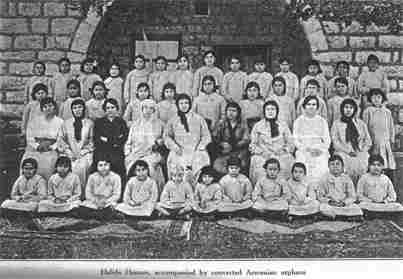
From the 1964
reprint: "Halide Hamum, accompanied by converted Armenian orphans." Below:
"Halide Hanum (sitting), a Turkish authoress, a most active worker at the
conversion of Armenians orphans to Islam. An Armenian girl (standing) is being
allured into harem life." The Chairman of AHRA, M. G. Sevag, wrote in the
book's foreword, after referring to the Turks' "inhuman practices" and
"demonic crimes, the case of Halide Edib Hanum is a loathsome example." An
excerpt from a propaganda work is cited: "It was Halide Hanum, a graduate of
the American College for girls at Constantinople, and Kemal's minister of
education... who directed the tearing apart of thousands of children from their
(Armenian) parents to be forced into Turkish homes, and the seizure of thousands of
young women to be turned over to the Turkish army for immoral purposes."
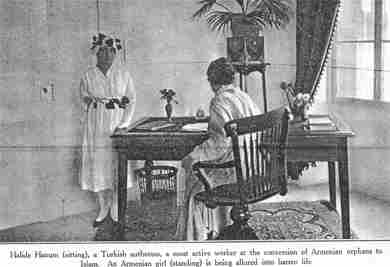
Ironically, it is Edib from whom we may learn that once the Ottomans were defeated, Turkish orphans were being Armenianized
(the occupying Allies in charge were, after all, completely in the corner of the
Armenians). Edib acknowledged conversions of Armenian orphans had taken place, but
from all the orphanages in existence, by what evidence do these awful propagandists
point an accusing finger at Edib herself? As with the "genocide," they
have no evidence, of course. The charge itself is all the "evidence" they
need. Simply abominable.
But let's get Gocek back into this. She wrote a
letter to one of the Armenian pages ("Aztag") proclaiming, "The French College in
Aintoura, Lebanon or Jemal Paha’s orphanage where Armenian children were to be
turkified" (NEW REVELATIONS ON THE ARMENIAN GENOCIDE, by Nora Parseghian).
This is an absolutely incredible article, purporting to prove the Turkification of
Armenian orphans was taking place, and under Edib's own hand.
In fact, the accusation goes far beyond: "Halide Hanum was a strong
supporter of the pashas who planned, organized and executed the Armenian Genocide
and played a crucial role in the efforts to turkify the remnants of the
Armenians." Yes, ladies and gentlemen, they actually made Edib out to be a
"genocide supporter." Is there no end to these people's lack of scruples?
The article immediately gets itself in trouble, as far as its observance of the
facts, with the assertion: "On October 29, 1914 the Ottoman Empire declared
war against France, Great Britain and Russia." Of course, it was these
countries that declared war upon the Ottoman Empire, and not the other way around.
(When Russia declared war on Nov. 2, the Ottoman-Armenians immediately attacked.)
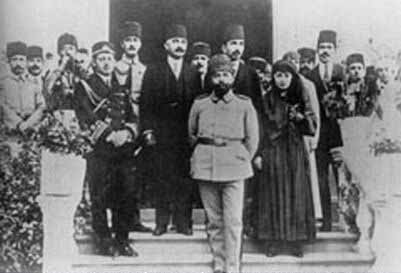
The "amazing" discovery the article points to is the "shocking"
photograph above, that an Armenian found in the popular pro-Armenian book, "The
Lions of Marash." We are told the caption read, "Jemal Pasha...on the
steps of the French College at Aintoura, Lebanon. Jemal Pasha had established an
orphanage for Armenian children in the college building and had appointed Halide
Edib to be its directress." In other words, it is this photograph they are
pointing to as "proof" that the Armenian orphans became Turkified.
The boneheads involved don't seem to be aware that Edib came aboard in 1916, and the
article tells us of the many Armenian orphans that were around (and not around; we
are told 300 eventually succumbed to the famine and disease that was going on all
over, but of course in this case, the Armenians must again appear as the exclusive
victims), after the Allies took over in late 1918. (We're not told exactly when Edib
left, an essential point if the idea is to accuse her of the "Turkification"
process. The article says the "Turkification" began in 1915, before her
arrival, and that she left after leprosy began in the summer of 1916. So she came in
1916, and left in 1916?)
I suppose we are to assume the Armenians among the orphans had all been "Turkified"
by the end, but the noble priest Father Sarlout came in, instantly identified (in an
unheralded historical example of "racial profiling") who the Armenians
were and who were the Turks, kicked the Turks and Kurds out to Damascus, and then
"work[ed] with" the Armenians to help them remember their Armenian
identity.
Incidentally, the second photo that has been reproduced above, with Halide Edib
sitting and "alluring" an Armenian girl into "harem life," has
also been included at this site. The caption at the Aztag site reads: "Halide
Hanum interviewing an Armenian girl." Of course, we have no way of knowing
the young woman in the picture is even an Armenian (she appears too old to be one of
the orphans), but leave it to Armenian propagandas to come up with any caption that
fulfills their despicable agenda. (I also like another of their captions showing a
huge crowd of orphans, and the description reads, "Turkified Armenian
orphans." That is, every single child there was an Armenian, because
non-Armenian orphans really didn't exist, and they all were "Turkified."
There is simply no stopping these unscrupulous people.)
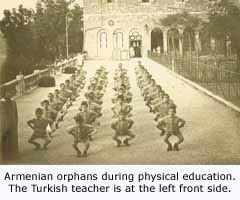 |
Contradictorily, another shot is featured,
reproduced at right, reading: "Armenian orphans during physical education.
The Turkish teacher is at the left front side." How is it possible these
orphans remained "Armenian," and didn't get "Turkified"?
Isn't it awful that these propagandists took the humanitarian actions of the Turks,
the taking care of Armenian orphans, and still tried to make villains of the Turks?
After all, if "Armenian Genocide" proponents tell us the idea was to
exterminate the Armenians (for racial reasons, remember... "Turkey for the
Turks"!), then why weren't these orphans done away with? Did Hitler establish
orphanages for Jewish children?
Here is how Fatma Muge Gocek responded in her Feb. 2, 2006 letter:
Dear colleagues,
Below please find the link an article by Missak Kelechian, who has unearthed amazing
old photographs of the Aintoura orphanage for armenian orphans established by Cemal
Pasha and run by Halide Edib (Adivar). [I should note here that it is probably
because of her experience at this orphanage that Halide Edib, while on her way from
Aintoura to Istanbul via the train, is introduced to Dr. Bahaeddin Shakir and, when
the latter leaves, complains to her companion for the introduction by stating: 'You
made me shake the hand of a murderer!' This comprises one of the few instances where
we have knowledge about the Turkish contemporaries knowing about the activities of
Bahaeddin Shakir].
(...) The first picture reveals the ottoman administrators who ran the site
surrounding a young Cemal Pasha: on his left is a very young looking Halide Edib.
The other photographs are all various scenes from the orphanage and there are other
pictures that contains Halide Edib as well.
I have some information from memoirs in Turkish on this orphanage (especially from
people who served with Cemal Pasha as well as the pasha himself) and i will send
that information to you separately.
I think it would be great if this article was translated into Turkish and came out
in Turkey as well.
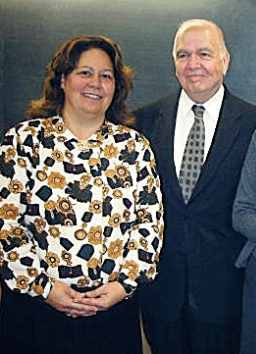 |
|
Fatma
Muge Gocek with Richard Hovannisian |
Fatma Gocek is actually referring to these
propagandists as "colleagues," showcasing some honesty. Obviously, she
read the article, and Gocek must have approved of the accusations made against Edib,
that she was practically a director of the "genocide," and that Edib
"Turkified" the Armenian orphans. Otherwise, how can Gocek even dare
associate with these horrid propagandists?
Yet, Gocek appears to be giving some slack to Edib, here. Gocek is saying that
somehow Edib got to know of the crimes of the Ottomans at the orphanage, and felt
terrible about shaking Shakir's hand, as a result. (Shakir, by the way, raised two
Armenian orphans as his own boys.) But does that make sense? The article tried to
define Edib as someone from Shakir's criminal crowd. Gocek is really confused, first
approving of this portrayal of Edib with the letter to her "colleagues,"
and then trying to make Edib out to be not such a bad person.
This excerpt of Edib's bristling away from Shakir is often encountered in propaganda
material, demonstrating what a "Heinrich Himmler" Shakir really was.
However, we just learned that Edib herself was very naive in 1916. It appears
Edib had this reaction while she was in her "Fatma Muge Gocek" (with
CAVEAT) phase, that Turks were bad, and Armenians were poor, innocent victims. She
really must not have known who Shakir was, and what he was really guilty or innocent
of, at the time. That is, she based her reaction on "hearsay," the kind of
thing genocide advocates point to as "proof."
|
| |
Edib's talk with Talat Pasha is confusing. On one
hand, she describes Talat as an "idealist," that is, one who pursues wrong
policies because of unrealistic beliefs. (Sort of like genocide advocates, who are
blind to the facts.) Then Edib demonstrates Talat was a good man, and was
forced into making tough decisions, during a desperate time, in order to save his
country.
Yet, Talat's protection of Edib, at the end of the 1916 speech when the Unionists
were ready to crucify her, is very telling about what a fair man Talat really was.
Would that kind of tolerant rationale emanate from a mastermind of a "Final
Solution"?
The last page ("Chapter 17") of the excerpts featured also shed light. The
credit for saving the "Smyrna" Armenians goes to Liman von Sanders in
Armenian propaganda (the German gave himself the credit. Yet if he had that much
power, why didn't he stop the other "deportations"?), but we can see Rahmi
Bey, the governor of Smyrna, had a lot to say about that decision.
And Jemal Pasha gets the credit he deserves, for his humanitarian actions. Once
again, phooey on the dishonest genocide crowd, for attempting to paint Jemal Pasha
as a monster... even when their own sources, like Lepsius himself, say otherwise.
Jemal saved Armenians, and he was murdered by Armenians, in a typical example of
extremist-Armenian "gratitude." Here is a look at parts of Jemal's memoirs.
Thanks to reader Cihan
|
| |
|
|